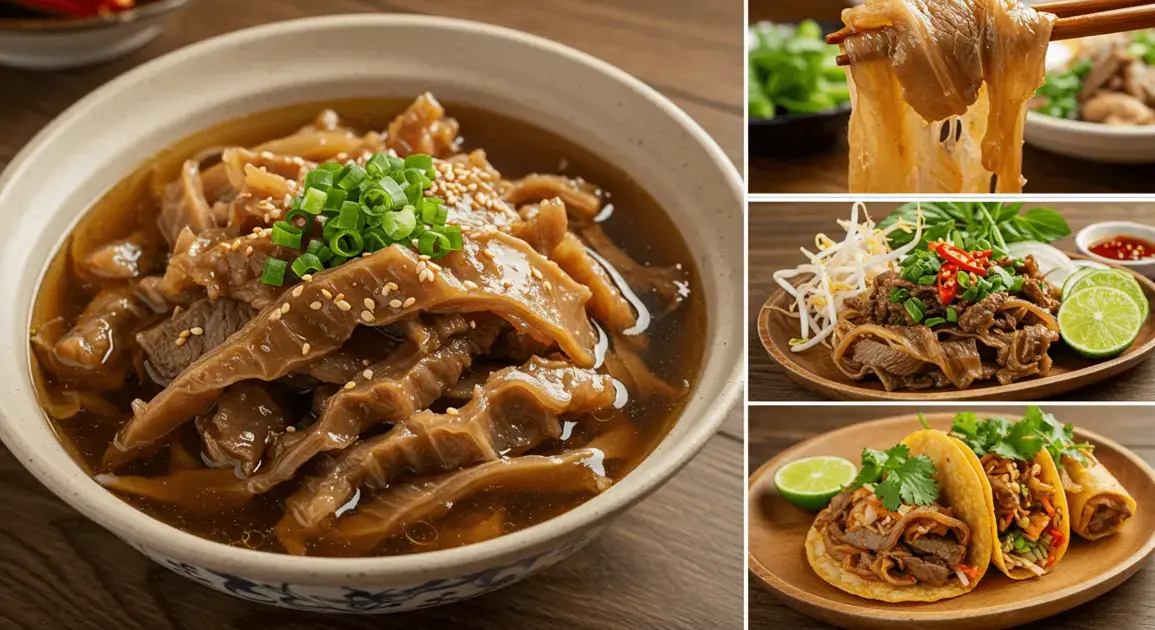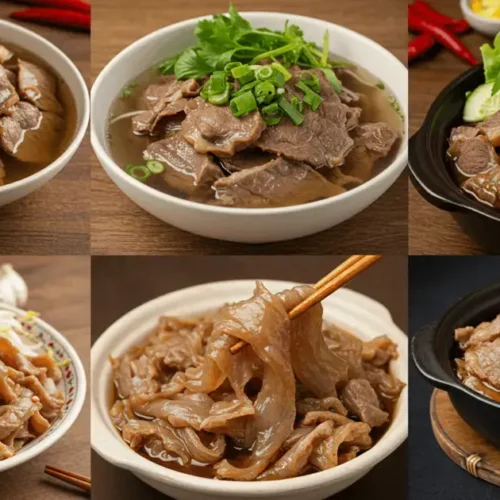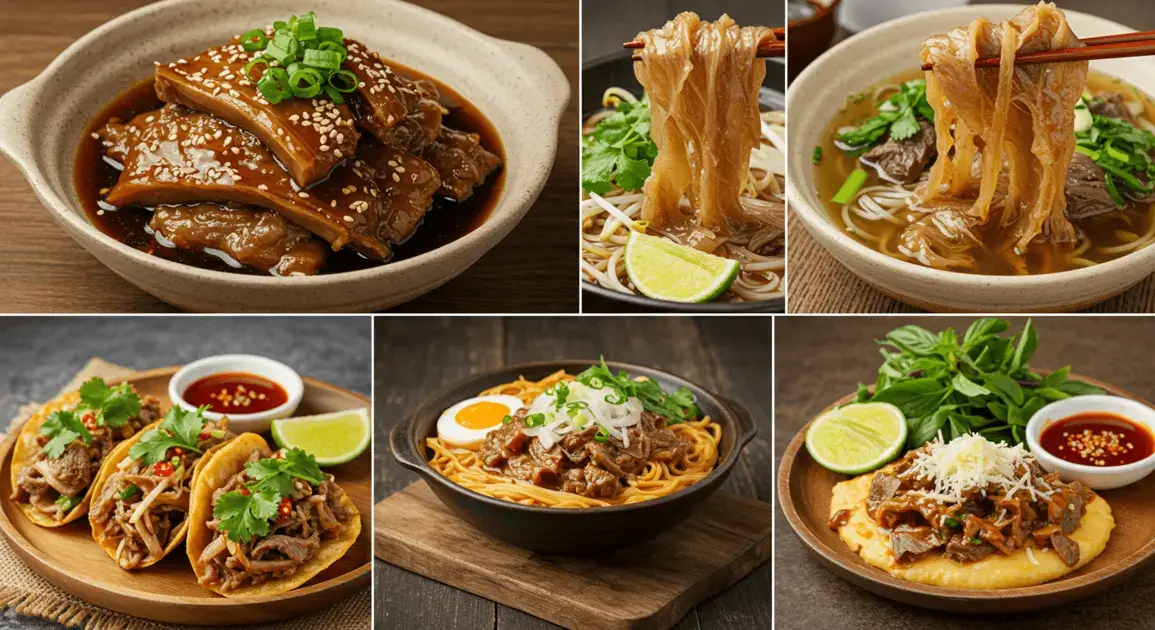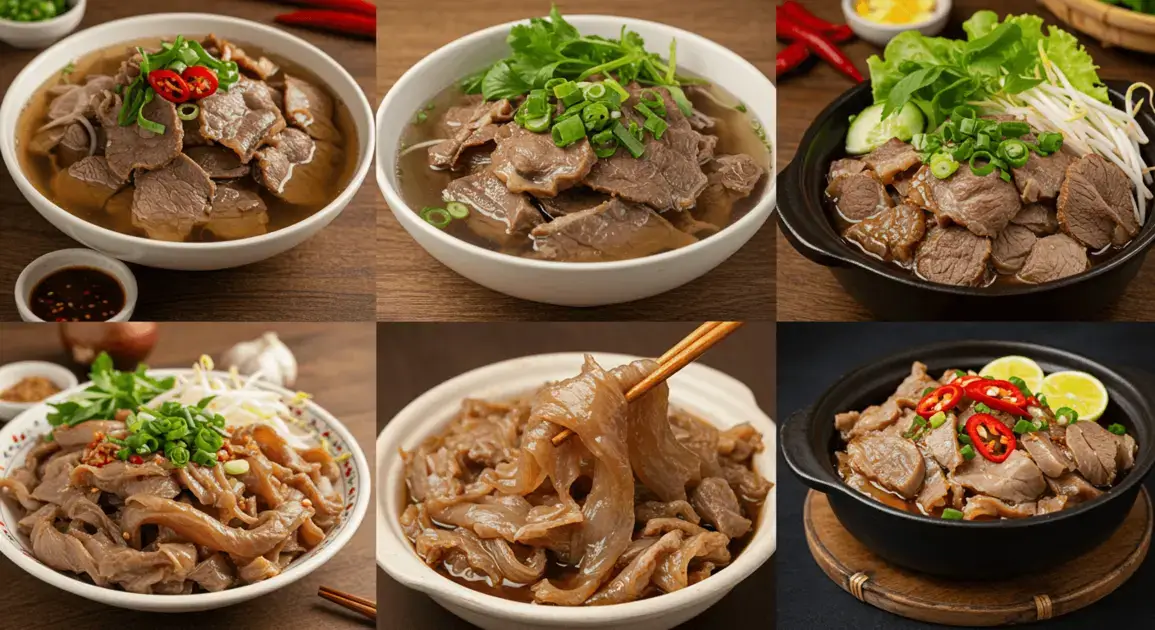
Table of Contents

Beef Tendon
Ingredients
- 500 g beef tendon
- 2 tbsp vegetable oil
- 3 slices ginger
- 3 cloves garlic, smashed
- 2 green onions, cut into sections
- 2 star anise
- 1 cinnamon stick
- 2 tbsp soy sauce
- 1 tbsp dark soy sauce
- 1 tbsp oyster sauce
- 1 tbsp Shaoxing wine (or dry sherry)
- 1 tsp sugar
- 2 cups beef or chicken broth
- salt to taste
Instructions
- Prepare the Tendon:Blanch the beef tendon in boiling water for 5 minutes. Drain and rinse.Make the Broth:In a large pot, char the onion and ginger over an open flame or in a skillet until slightly blackened.Add the charred onion, ginger, cinnamon sticks, star anise, cloves, cardamom, and coriander seeds to the pot with beef broth.Add the beef tendon and brisket. Simmer for 2-3 hours until the tendon is tender.Prepare the Noodles:Cook rice noodles according to package instructions. Rinse under cold water and set aside.Assemble the Pho:Slice the cooked brisket and tendon thinly.Place noodles in bowls, top with sliced beef and tendon, and ladle hot broth over them.Serve with bean sprouts, Thai basil, cilantro, lime wedges, and chili slices on the side.
A Brief Introduction to Beef Tendon
Beef tendon, a humble yet extraordinary ingredient, is a testament to the ingenuity of traditional cooking. Derived from the connective tissues of cattle, it is prized for its gelatinous texture and ability to absorb rich flavors. While often overlooked in Western cuisines, beef tendon holds a revered place in many global culinary traditions, from Asia to Africa and Latin America.
When cooked properly, beef tendon transforms into a tender, almost luxurious component that adds depth and complexity to dishes. Its unique texture and collagen-rich composition make it a favorite among chefs and home cooks who appreciate its versatility and nutritional benefits. For those willing to explore beyond the familiar, beef tendon offers a world of culinary possibilities.
The History and Cultural Significance of Beef Tendon
The use of beef tendon is deeply rooted in the history of resourcefulness and sustainability. Across cultures, it symbolizes the philosophy of “nose-to-tail” eating, where every part of the animal is utilized to minimize waste and maximize flavor.

Chinese Cuisine: A Symbol of Prosperity
In Chinese culture, beef tendon is more than just an ingredient—it’s a symbol of prosperity and resilience. It is often served during celebrations and family gatherings, particularly in dishes like braised beef tendon, which is a staple of dim sum cuisine. The dish’s tender texture and rich flavor are believed to bring good fortune and strength.
Japanese Cuisine: Comfort in a Bowl
In Japan, beef tendon is a key component of oden, a comforting winter stew. Oden features a variety of ingredients, including daikon radish, fish cakes, and boiled eggs, simmered in a light dashi broth. The addition of beef tendon adds a luxurious, gelatinous texture that complements the dish’s umami-rich flavors.
African and South American Traditions: Bold and Hearty
In many African and South American cultures, beef tendon is celebrated for its ability to absorb bold flavors and contribute to hearty, satisfying meals. In South America, it is a key ingredient in locro, a traditional stew made with corn, beans, and spices. This dish reflects the region’s love for robust, flavorful meals that bring people together.
Global Adaptations: A Culinary Chameleon
From Vietnamese pho to Korean gukbap, beef tendon has found its way into a variety of iconic dishes around the world. Its adaptability and ability to enhance the texture and flavor of dishes make it a beloved ingredient in many culinary traditions.
Nutritional Benefits of Beef Tendon

Beef tendon is not only a culinary delight but also a nutritional powerhouse. Its high collagen content and rich mineral profile offer numerous health benefits:
Collagen for Joint and Skin Health
Collagen, the primary protein in beef tendon, is essential for maintaining skin elasticity, joint health, and overall vitality. When cooked, collagen breaks down into gelatin, which supports gut health and aids digestion.
High Protein, Low Fat
Beef tendon is low in fat and high in protein, making it an excellent addition to diets focused on muscle repair and weight management. It provides essential amino acids necessary for tissue repair and growth.
Rich in Minerals
Beef tendon is a good source of minerals like calcium, magnesium, and zinc, which contribute to bone strength, cardiovascular health, and immune function.
Nutritional Breakdown (Per 100g):
| Nutrient | Amount |
|---|---|
| Protein | 10g |
| Collagen | 8g |
| Vitamin B12 | 1.5μg |
| Iron | 2mg |
| Zinc | 3mg |
Tips for Cooking Tender, Delicious Beef Tendon
Cooking beef tendon requires patience and technique to achieve its signature melt-in-your-mouth texture. Here are some expert tips:
- Pre-Boil for Cleanliness: Blanch the tendon in boiling water for 5-10 minutes to remove impurities and achieve a cleaner flavor.
- Low and Slow Cooking: Braise or simmer the tendon for several hours to break down the collagen and create a tender, gelatinous texture. A pressure cooker can reduce cooking time without compromising quality.
- Infuse Flavor: Use aromatic ingredients like ginger, garlic, star anise, and soy sauce to enhance the tendon’s natural richness.
- Rest Before Serving: Allow the cooked tendon to cool slightly before slicing to help it retain its shape and texture.
Cooking Methods and Times:
| Method | Time | Texture |
|---|---|---|
| Slow Simmering | 3-5 hours | Soft, gelatinous |
| Pressure Cooking | 1-2 hours | Tender, fall-apart |
| Braising | 2-3 hours | Meltingly tender |
Popular Beef Tendon Dishes Around the World
Beef tendon is a star ingredient in many iconic dishes across the globe. Here are some highlights:
1. Chinese Braised Beef Tendon
A classic dim sum dish, braised beef tendon is simmered in a rich soy-based broth with aromatic spices. The result is a tender, flavorful appetizer often served with steamed rice or noodles.
2. Vietnamese Pho
In Vietnamese cuisine, beef tendon is a key component of pho, the beloved noodle soup. The tendon’s gelatinous texture adds depth to the broth, creating a satisfying and hearty meal.
3. Korean Gukbap
This hearty stew features beef tendon, rice, and vegetables in a savory broth. It’s a comforting dish often enjoyed during colder months.
4. Thai Kuay Tiew Nuea
A spicy noodle soup, kuay tiew nuea combines tender beef tendon with aromatic herbs, chili, and rice noodles for a bold and flavorful dish.
5. South American Locro
A traditional stew, locro features beef tendon alongside corn, beans, and spices. It’s a hearty and nutritious meal that showcases the tendon’s ability to absorb bold flavors.
Creative Recipes and Meal Ideas

Beyond traditional dishes, beef tendon can be used in innovative ways to create exciting meals. Here are some ideas:
1. Beef Tendon Spring Rolls
Thinly slice cooked tendon and combine it with crisp vegetables, herbs, and glass noodles in rice paper wrappers. Serve with a tangy dipping sauce for a refreshing appetizer.
2. Fusion Beef Tendon Tacos
Fill corn tortillas with sautéed tendon, pickled onions, spicy aioli, and fresh cilantro for a modern twist on a classic dish.
3. Beef Tendon Ragu
Use diced tendon as the base for a rich and hearty ragu. Simmer with tomatoes, red wine, and herbs, then serve over pasta or polenta.
4. Beef Tendon Salad
Add sliced tendon to a salad for a unique textural contrast. Pair with fresh greens, herbs, and a zesty dressing.
Beef Tendon’s Role in Traditional and Alternative Medicine
In addition to its culinary uses, beef tendon has long been valued in traditional and alternative medicine for its health benefits.
Traditional Chinese Medicine
In TCM, beef tendon is believed to support joint health, reduce inflammation, and improve mobility. It is often recommended for individuals with arthritis or joint pain.
Ayurvedic Medicine
In Ayurveda, beef tendon is used to strengthen connective tissues and promote overall vitality. It is considered a nourishing food that supports physical and mental well-being.
Modern Health Trends
Today, beef tendon is gaining popularity as a natural source of collagen, which is widely used in supplements and skincare products. Its nutritional profile makes it a valuable addition to a balanced diet.
Conclusion: Exploring the World of Beef Tendon
Beef tendon is a versatile, nutritious, and culturally significant ingredient that deserves a place in every home cook’s repertoire. Whether you’re drawn to its historical roots, health benefits, or culinary potential, beef tendon offers endless opportunities for creativity and exploration.
From traditional dishes like Chinese braised tendon and Vietnamese pho to modern creations like fusion tacos and spring rolls, this humble ingredient can elevate any meal. So why not embrace the challenge and experiment with beef tendon in your kitchen? Share your experiences, favorite recipes, and unique preparation tips with others, and join the growing community of beef tendon enthusiasts.
This expanded version provides a comprehensive overview of beef tendon, blending cultural insights, practical tips, and creative recipes to engage and inspire readers. Let me know if you’d like further refinements or additional content! 😊
Choose what you like from the Lunch menu to start your day happily
what did you think about this recipe?
There are no reviews yet. Be the first one to write one.
1 thought on “Unlock the Secrets of Beef Tendon: A Delicate, Nutrient-Packed Culinary Gem”